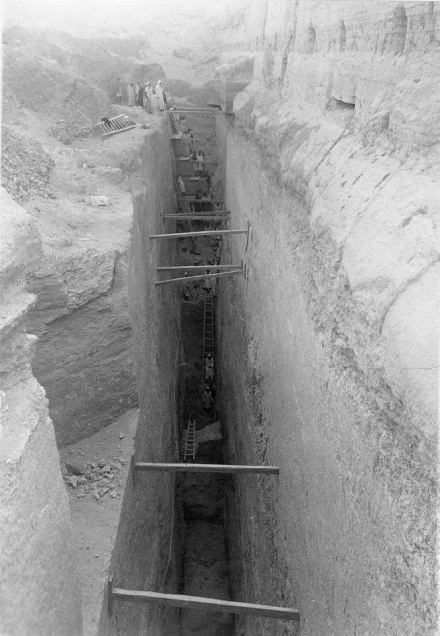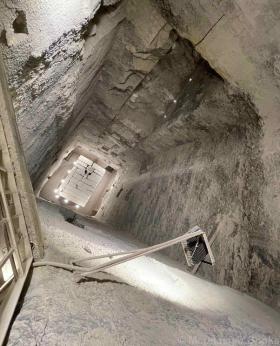Follow us on Google News (click on ☆)

Illustration of a hydraulic system behind the construction of the Saqqara Pyramid
© Paleotechnic
The scientific article, published in the journal PLOS One, uncovers the existence of a complete and modern hydraulic system, which is thought to have facilitated the erection of Egypt's first monumental pyramid akin to a "volcano," with construction materials arriving at its central axis.
This hydraulic network consists of a dam, a water treatment facility, underground conduits, and a hydraulic lift—structures with functions never before identified.
Built approximately 4,700 years ago, the Step Pyramid of Djoser on the Saqqara plateau, is considered the oldest of Egypt's seven monumental pyramids. Seen as a precursor to the Great Pyramid of Khufu, its innovative architecture features major innovations such as the use of millions of cut stones and an underground complex with more than 4 miles (7 km) of galleries.

Synthetic view of the Saqqara plateau illustrating the main discoveries of the scientific article
Three major discoveries
From a multidisciplinary analysis incorporating nearly a dozen distinct specialties within three research organizations, researchers discovered that one of the unexplained structures on the Saqqara plateau, known as the "Gisr el-Mudir," exhibits the technical signatures of a dam. Sometimes regarded as the oldest monumental stone structure in the world, the function of the Gisr el-Mudir remained unknown and widely debated, with hypotheses ranging from a cattle enclosure to a fortress, or a pharaonic celebration arena.
This dam, enormous in its dimensions (nearly 1.2 miles long and 49 feet wide - 2 km long and 15 meters wide), actually has all the characteristics of a sediment trap. Built between two valley slopes, it would have allowed for the regulation and rough filtration of water while providing protection against flash floods for the Saqqara plateau situated below.
Downstream of the dam, a topographic study revealed the possible existence of an intermittent lake, connected with the immense moat surrounding the Djoser complex, a hypothesis confirmed by geophysical and sedimentary analyses from other European research teams.

Left: satellite view of the Gisr el-Mudir. Right: topographic reconstruction.
A water treatment facility
In the southern part of the moat surrounding the Djoser complex, researchers studied a monumental excavation, the "Deep Trench," 1,312 feet long (400 meters) and about 89 feet deep (27 meters), entirely carved into the rock, whose function had not been previously explained.
By cross-referencing hydrological analyses and past archaeological results, researchers demonstrated that this structure, which includes several successive compartments, had all the technical characteristics of a water treatment facility. These compartments correspond to a sedimentation basin, a retention basin, and a water purification system.
Together with the Gisr el-Mudir dam, the Deep Trench thus formed a complete hydraulic system capable of purifying and regulating large volumes of water to meet practical needs or to fulfill the vital needs of workers on the Saqqara plateau.

Image from 1943 of the "Deep Trench"*. The authors discovered that this trench, entirely carved into the rock, 89 feet deep (27 meters) and nearly 1,312 feet long (400 meters), corresponds to a very sophisticated water treatment installation.
The hydraulic lift, a revolutionary construction method
The central discovery of the scientific publication, the research team demonstrated that the internal architecture of the Step Pyramid of Saqqara corresponds to a hydraulic lift mechanism.
The researchers show that water from the Deep Trench treatment facility would have been introduced into the underground conduit network below the Djoser Pyramid (4 miles or 7 km of conduits previously unexplained).
Through this hydraulic network, the water would have been guided to the central shaft located under the pyramid (about 92 feet deep - 28 meters) and allowed, through cycles of filling and draining, the elevation of a float carrying stones. The Djoser Pyramid would have been erected in a "volcano-like" manner with construction materials arriving at its central axis.

View of the central shaft under the Djoser Pyramid, with at the bottom the plug system previously thought to be the pharaoh's sarcophagus.
Based on available paleoclimatic data and mapping of surrounding watersheds, the researchers demonstrate, using a hydromechanical model, that the water resource available during the construction period was sufficient to enable the pyramid's construction.
"This work opens a new line of research for the scientific community: the use of hydraulic force for the construction of Egypt's pyramids. More importantly, this work challenges the level of technical knowledge achieved by the architects of these structures, which far exceeds previously attributed capabilities. More widely, it questions the established historical narrative. Finally, the study raises another question: where is the tomb of Pharaoh Djoser? Could this system, likely used to erect the pyramid, have allowed the king to be placed in his final resting place, within the heart of the pyramid itself?" Xavier Landreau, President of Paleotechnic, researcher at CEA, and lead author.
Numerical simulation of the flow within the hydraulic network beneath the pyramid (4 miles or 7 km of conduits).Representation of the Saqqara hydraulic system discovered by the authors.
Notes:
* Image of Swelim N. The dry moat, the south rock wall of the inner south channel. E. Czerny, et al. (eds.), OLA 149; 2006.
On the possible use of hydraulic force to assist with building the step pyramid of Saqqara. Xavier Landreau, Guillaume Piton, Guillaume Morin, Pascal Bartout, Laurent Touchart, Christophe Giraud, Jean-Claude Barre, Cyrielle Guerin, Alexis Alibert, Charly Lallemand, PLOS. Published: August 5, 2024.
https://doi.org/10.1371/journal.pone.0306690